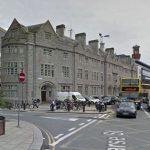The Fall Of The Berlin Wall: 29 years ago this month

November 9th marked one of the most important anniversaries of modern times. This date marks the 29th anniversary of the fall of the Berlin wall. The wall itself was both the physical division between West Berlin and East Germany from 1961 to 1989 and the symbolic boundary between democracy and Communism during the Cold War. In the years between 1949 and 1961, approximately 2.5 million East Germans had fled from East to West Germany, including steadily rising numbers of skilled workers, professionals, and intellectuals.
Their loss threatened to destroy the economic viability of the East German state. In response, East Germany built a barrier to close off East Germans’ access to West Berlin (and hence West Germany). The wall was initially erected on the night of August 12–13, 1961, as the result of a decree passed on August 12 by the East German Volkskammer (“Peoples’ Chamber”).
The original wall, built of barbed wire and cinder blocks, was subsequently replaced by a series of concrete walls (up to 15 feet high) that were topped with barbed wire and guarded with watchtowers, gun emplacements, and mines. By the 1980s this system of walls, electrified fences, and fortifications extended 45 km through Berlin, dividing the two parts of the city, and extended a further 120 km around West Berlin, separating it from the rest of East Germany.
After the Second World War, the Allied powers divided conquered Germany into four zones. Each of these was occupied by either the United States, Great Britain, France, or the Soviet Union (as agreed at the Potsdam Conference). The same was done with the German capital, Berlin.
As the relationship between the Soviet Union and the other three Allied powers quickly disintegrated, the cooperative atmosphere of the occupation of Germany turned competitive and aggressive. Although an eventual reunification of Germany had been intended, the new relationship between the Allied powers turned Germany into West versus East and as a result, democracy versus Communism.
In 1949, this new organisation of Germany became official when the three zones occupied by the United States, Great Britain, and France combined to form West Germany (the Federal Republic of Germany). The zone occupied by the Soviet Union quickly followed by forming East Germany (the German Democratic Republic).
This same division into West and East occurred in Berlin. Since the city of Berlin had been situated entirely within the Soviet zone of occupation, West Berlin became an island of democracy within Communist East Germany.
Within a short period of time after the war, living conditions in West Germany and East Germany became distinctly different. With the help and support of its occupying powers, West Germany set up a capitalist society and experienced such a rapid growth of their economy that it became known as the “economic miracle.” With hard work, individuals living in West Germany were able to live well, buy gadgets and appliances, and to travel as they wished.
Nearly the opposite was true in East Germany. Since the Soviet Union had viewed their zone as a spoil of war, the Soviets pilfered factory equipment and other valuable assets from their zone and shipped them back to the Soviet Union. When East Germany became its own country, it was under the direct influence of the Soviet Union and thus a Communist society was established. In East Germany, the economy dragged and individual freedoms were severely restricted.
By the late 1950s, many people living in East Germany wanted out. No longer able to stand the repressive living conditions of East Germany, they would pack up their bags and head to West Berlin. Although some of them would be stopped on their way, hundreds of thousands of others made it across the border. Once across, these refugees were housed in warehouses and then flown to West Germany. Many of those who escaped were young, trained professionals. By the early 1960s, East Germany was rapidly losing both its labour force and its population.
Having already lost 2.5 million people by 1961, East Germany desperately needed to stop this mass exodus. The obvious leak was the easy access East Germans had to West Berlin. With the support of the Soviet Union, there had been several attempts to simply take over West Berlin in order to eliminate this exit point. Although the Soviet Union even threatened the United States with the use of nuclear weapons over this issue, the United States and other Western countries were committed to defending West Berlin.
Desperate to keep its citizens, East Germany decided to build a wall to prevent them from crossing the border. There had been rumours that something might happen to tighten the border of East and West Berlin, but no one was expecting the speed or the absoluteness of the wall.
Just past midnight on the night of August 12-13, 1961, trucks with soldiers and construction workers rumbled through East Berlin. While most Berliners were sleeping, these crews began tearing up streets that entered into West Berlin, dug holes to put up concrete posts, and strung barbed wire all across the border between East and West Berlin. Telephone wires between East and West Berlin were also cut.
Berliners were shocked when they woke up that morning. What had once been a very fluid border was now rigid. No longer could East Berliners cross the border for operas, plays, soccer games, etc. No longer could the approximately 60,000 commuters head to West Berlin for well-paying jobs. No longer could families, friends, and lovers cross the border to meet their loved ones. Whichever side of the border one went to sleep on during the night of August 12, they were stuck on that side for decades.
Although most of the border between East and West consisted of layers of preventative measures, there were little more than a handful of official openings along the Berlin Wall. These openings, called checkpoints, were for the infrequent use of officials and others with special permission to cross the border.
The most famous was Checkpoint Charlie, located on the border between East and West Berlin at Friedrichstrasse. This was the main access point for Allied personnel and Westerners to cross the border. The wall was effective in that it did prevent the majority of East Germans from emigrating to the West, but it could not prevent them all. During the history of the Berlin Wall, it is estimated that approximately 5,000 people made it safely across.
Early successful escape attempts were simple in there execution. Some involved throwing a rope over the wall and climbing up and over it. Others were not a subtle. These included things like ramming a truck or bus into the wall and making a run for it. Others were suicidal, born out of complete desperation like jumping from the not-yet-boarded-up, upper-story windows of apartment buildings that bordered the Berlin Wall.
As the Berlin Wall became stronger and larger, the escape attempts became more planned and more complex. Some people dug tunnels from the basements of buildings in East Berlin, under the Berlin Wall, and into West Berlin. Another group saved scraps of cloth and built a hot air balloon and flew over the Wall. This was a dangerous task as the East German guards were allowed to shoot anyone nearing the eastern side of the Berlin Wall without warning so there was always a chance of death in any and all escape plots. It is estimated that somewhere between 100 and 200 East Germans died while attempting to cross the Berlin Wall.
The fall of the wall occurred almost as suddenly as its rise. There were strong and significant indications that the Communist bloc was weakening, but the East German Communist leaders insisted that East Germany just needed a moderate change rather than a drastic revolution. The citizens of East Germany did not agree.
As Communism began to falter in Poland, Hungary, and Czechoslovakia in 1988 and 1989, new exodus points were opened to East Germans who wanted to flee to the West. Thenout of seemingly nowhere, on the evening of November 9, 1989, an announcement made by East German government official Günter Schabowski who stated, “Permanent relocations can be done through all border checkpoints between the GDR (East Germany) into the FRG (West Germany) or West Berlin.”
This announcement left people in utter shock. Could they be sure that the borders really were open? East Germans gathered and cautiously approached the border to find found that the guards were letting people cross. Very quickly, the Berlin Wall was inundated with people from both sides. Some began chipping at the Berlin Wall with hammers and chisels.
There was an impromptu huge celebration along the Berlin Wall, with people hugging, kissing, singing, cheering, and crying. The eyes of the world turned to Berlin to witness one of the most significant moments of the 20th century. The wall had finally come down, both physically and metaphorically. The East and West had finally reunited into a single state on October 3, 1990.But nobody will ever forget the historic events of November 9th 1989.

